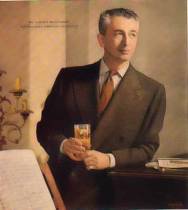
Vladimir Golschmann (16 December 1893 – 1 March 1972) was born in Paris of Russian parents and as a child he learnt to play both violin and piano; at the Schola Cantorum he studied in addition composition, counterpoint and harmony. Having started his musical career as an orchestral violinist with the Concerts Rouges under André Caplet, he went on to play in three of the Parisian symphony orchestras. However his ambition was to be a conductor: in 1919 he initiated the Concerts Golschmann, which were given by an orchestra of approximately thirty musicians under his direction, and at which contemporary music was strongly featured, with music by composers such as Ibert, Prokofiev, and Tansman as well as the members of Les Six. In 1920 Diaghilev engaged Golschmann to conduct the first revival in Paris since its première in 1913 of Stravinsky’s The Rite of Spring. He also conducted the Popular Concerts in Brussels, and chamber operas by Ibert, Milhaud, Florent Schmitt and others at the Beriza Theatre, Paris, of which he was musical director. For five years Golschmann was chief conductor of the Bilbao Symphony Orchestra, and from 1928 to 1930 of the Scottish Orchestra. He made his American debut in 1923 as conductor of the Ballets Suédois, and this was followed in 1924 by guest engagements with the New York Symphony Orchestra. After a successful debut with the St Louis Symphony Orchestra in 1931 Golschmann was immediately appointed as its chief conductor, bolstered by strong recommendations from Walter Damrosch and Serge Koussevitzky. His excellent technique helped to develop the St Louis Symphony Orchestra into a first-class ensemble, if not quite of the same calibre as that of the leading American orchestras, and he remained as its chief conductor until 1956, moving permanently to the USA in 1934 and taking American citizenship in 1947. Golschmann subsequently maintained his connection with St Louis as conductor emeritus of its orchestra, and in 1957 was a visiting professor at the city’s George Washington University, which awarded him an honorary doctorate. He also enjoyed a freelance career throughout North and South America and Europe, and continued an active musical career until shortly before his death, as chief conductor firstly of the Tulsa Symphony Orchestra from 1958 to 1961, and then of the Denver Symphony Orchestra from 1964 to 1970.
A strong supporter of contemporary music, Golschmann conducted the world premières of Honegger’s Pastorale d’été (1921), Falla’s El retablo de maese Pedro (1923), Milhaud’s La Création du monde (1923), Ibert’s Divertissement (1930), and Tansman’s Symphony No. 7 (1947). Although by nature a romantic, he possessed the ability to interpret the music of a wide range of composers with sympathy and understanding, as his wide recorded repertoire clearly demonstrates. He was also a first-class accompanist, recording extensively with soloists of the calibre of Glenn Gould, William Kapell, Nathan Milstein, Leonard Pennario and Arthur Rubinstein. His numerous recordings with the St Louis Symphony Orchestra included characterful accounts of Schoenberg’s Verklärte Nacht, Shostakovich’s Symphony No. 5, Sibelius’s Symphony No. 7, and César Franck’s Symphony in D minor. With the Concert Arts Orchestra of Capitol Records he recorded Honegger’s Pastorale d’été, Ravel’s Le Tombeau de Couperin, Barber’s Adagio, Copland’s Quiet City, Creston’s Two Choric Dances, and Diamond’s Rounds.
Golschmann’s most extensive recording relationship was with the Vanguard record label, for which, together with the Vienna State Opera Orchestra, he recorded popular repertoire that included Berlioz’s Symphonie Fantastique, Mendelssohn’s Symphony No. 4, Brahms’s Symphony No. 4, Dvořák’s Symphony No. 9 ‘From the New World’, Tchaikovsky’s Symphony No. 6 ‘Pathétique’, Mussorgsky’s Pictures at an Exhibition and suites from the ballets Gayaneh by Khachaturian and The Comedians by Kabalevsky; as well as more adventurous repertoire such as Schoenberg’s Pierrot Lunaire, the Violin Concerto and Concerto Symphonique of Ernest Bloch, Roy Harris’s Symphony No. 4 ‘Folksong Symphony’, and an important album of music by Samuel Barber that included his Music for a Scene from Shelley, Essay No. 2, A Hand of Bridge and Serenade. Golschmann was not a conductor to be ranked with the greatest, yet his sure musicality has ensured that his recordings remain stylish and satisfying.
J. Sibelius: Symphony No.7 Rec.: 1942
W.A. Mozart: Symphony No.38 Rec.: 1945 St. Louis Symphony Orchestra Conductor: Vladimir Golschmann
|

